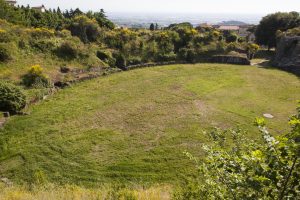TEMPORARILY CLOSED.
The amphitheatre was built by the masons of the Legion in the first half of the 3rd century AD, outside the north wall of the camp. It was built for the Legion’s entertainment and was able to seat up to 16.000 people. It is possible to admire the whole monumental building along the road of the amphitheatre from an overhead position given by the natural prospective of the land. This oval structure, built on very slanting ground, was partly dug out of the rocky bank and partly constructed using different building techniques. In order to reinforce the flat space a terraced substructure was built and also used as a stopover for travelers or for carts and people on the move.
The two vomitoria (triumphal entrances) were placed inside the major axis; a tunnel was built under the arena, which not only served to collect water but also to allow beasts to enter the arena through an elevator. Little remains of the cavea but the pulvinar (imperial podium) is still evident today.
In the Middle Ages the site was exploited as a source of building materials and later transformed into a place of worship and a Christian cemetery as the remains of some burial niches and the two oratories reveal (one found on the apse of the third archway where frescoes of St. Stefano, St. Lorenzo, St. Nicola, St. Pancrazio and an unknown Papa can be seen; the second one carved in the rock on the left side of the parapet of the cavea). Excavations were carried on by Giacomo Mancini in 1912 and in 1914 by Giuseppe Lugli, both highly qualified researchers of the Amphitheatre.
In 2000, Albano completed the restoration and excavations work uncovering further ruins and burial evidence. You can visit the Amphitheatre by contacting the Museo Civico di Villa Ferrajoli (Civic Museum of Villa Ferrajoli). Entrance fee charge.
For practical information www.museocivicoalbano.it


 Visit Castelli Romani
Visit Castelli Romani 


